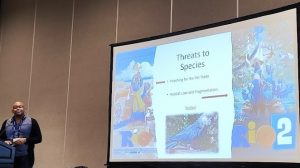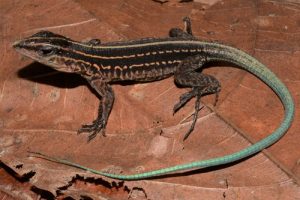Plant and Animal Genomes (PAG) 32nd annual conference
The 32nd Plant and Animal Genomes (PAG) Conference 2025 was a whirlwind of fascinating talks and innovative research! As in previous years (see previous blog posts here & here), the event spanned 5 complete days, this time the organisers reporting 2349 registered attendees from 64 countries. The top 5 represented countries were (highest number of participants first); USA, Canada, UK, Germany and China.
This is always a mammoth event, with over 2,000 presentations (including 7 plenary lectures) in over 200 sessions, and as many as 15 concurrent sessions at any one time. As always at PAG, one of the hardest things to do is decide which sessions to attend. Inevitably there are many great talks that one has to miss due to overlaps, so this blog only covers the small fraction of things that I was able to see.
Maybe this is just a reflection of my personal choices, but there were 3 main topics that appeared to be threaded throughout the conference: Conservation, Evolutionary genomics (including ancient genomes), and sustainable agriculture.
Conservation Genomics
Conservation Genomics has always been an area of particular interest to GigaScience, and while PAG was underway our Publishing Director Laurie Goodman was participating, supporting and teaching in the ConGen-Global-2025 – Recent Advances in Conservation Genetics meeting at the Cheetah Conservation Fund Research Center in Namibia. Back in San Diego, the ORG.one genomes for conservation of endangered species session featured 9 examples of groups leveraging the Oxford Nanopores generous ORG.one project to sponsor and create reference genomes of endangered species using ONT long reads technology. This including one talk from the (self proclaimed) “crazy birdman” Taylor Hains on the Spix’s Macaw genome, the species starring in the blockbuster movies Rio and Rio 2.

The Spix’s Macaw was declared extinct in the wild in 2019. However, a successful captive breeding program and an ongoing reintroduction to the native habitat has shown promise. It is being aided by the high quality genome data being produced to elucidate the evolutionary history and guide breeding programs to ensure the long-term viability of the species. We are big fans of parrot conservation and genomics (see “the peoples parrot” we published and promoted in our launch year), and it was nice to see another emblematic parrot species potentially come back from the brink with the aid of genomics.
The emphasis on collaboration with local scientists was evident in the “Conservation of Ecuadorian Biodiversity in the Genomics Era” presentation by Daniel Chavez. Where the local scientific community was critical in gaining the samples and generating the data on several of the amazing species found in Ecuador, including the South American Lion, Ecuadorian blue whale, the flightless Galapagos rail, and the fabulous blue whiptail lizard.

Photo credit: iNaturalist (CC BY-NC), Mario Humberto Yánez-Muñoz
In another session hosted by another of the sequencing companies, PacBio, also featured multiple talks from users of this technology; Including PhD student Eugenie ‘Charley’ Yen (Queen Mary U of London). Charley presented how The Turtle Project is using nanopore sequencing for genomic & epigenomic approaches for conservation of endangered loggerhead sea turtles – even taking the P2 device into the field to deploy methylation-based biomarkers in real-time!
Evolutionary & Ancient genomics
A number of sessions included some use of genomics to elucidate the evolution and distribution of plants and animals over time. This was highlighted in the plenary keynote presentation by Daniel Bradley entitled “Animal Domestication in the Fertile Crescent: Ancient Genomics and Origins of Cattle, Sheep and Goat”. Archaeological studies have shown that domestication of animals started around the late aceramic neolithic period 9-10,000 years ago. Here Dr Bradley presented studies of DNA sequences generated from bones of many animals, his work shows that it is becoming routine to be able to generate reference quality genomes from ancient bones. The analysis of the domestic animals found colocated with early human settlements help track the progression of domestication, and shows in cattle there were multiple regressions over time with the Aurochs predecessor to the modern day cattle species.
In fact an entire session was dedicated to presentations on ancient DNA called “Degraded DNA and Paleogenomics”. This season featured talks on agricultural crops like Maize from the Andes, genetic entanglements of wolves and dogs to shape the genome of the modern canine, and even looking at ancient microbes and metagenomics.
The final presentation in the session was a continuation of a talk featured in the same workshop last year ”A Nearly Contiguous Thylacine Reference Genome and Other Progress Toward Thylacine De-Extinction”. Sara Ord (Colossal Biosciences) continued the fascinating story of attempts to bring back the Thylacine to Tasmania. Why do that? In the case of the Thylacine, there seems to be a number of supprting arguments; (a) Its a relatively recent extinction event with the last known animal dying in 1936. (b) It was completely down to humans (encouraged by government bounties, paid out from 1888 to 1909) that the species was wiped out. (c) The species was the apex predator on Tasmania, and since its extinction there is widespread evidence that the ecosystem has suffered various catastrophes, including the spread of the Tasmanian devil face cancer that is now threatening to make that species extinct. For more information see the recent press release.
AgroGenomics & sustainable agriculture
“Healthy Plants; Healthy People – Fortifying Vitamins and Phytonutrients in Tomato” was the keynote presentation by Cathie Martin (John Innes Centre). Cathie explained that globally, Vitamin D (sunshine vitamin) insufficiency is common, with Europe averaging a 40% insufficiency rate. The USA has the fewest issues due to mandated Vitamin D fortification in some products. Most Vit D comes from exposure to sunlight, but when your shadow is longer than you are tall, your body isn’t producing any Vitamin D from sunlight!. In the UK and other similar latitudes, this occurs between October and March. Consequently, we must obtain Vitamin D from dietary sources instead, but very few plants produce it either.
Therefore, attempts are being made to engineer Vitamin D-producing plants, such as tomatoes. Using CRISPR-Cas9, scientists knocked out the gene converting the Vitamin D precursor (naturally occurring in solanum plants) to cholesterol, allowing the precursor to be converted to Vitamin D by UV light instead. These purple tomatoes have been shown to have a much higher Vitamin D content, especially if grown in the presence of UV light (i.e. outdoors not under glass), they are seeking regulatory approval to produce the plant for commercial sale.
As you would expect at PAG, there were many other sessions, talks and posters on agricultural crops and farm animals. The AgBioData session highlighted a variety of databases and resources that focus on agriculturally significant species data, and how they promote and safeguard data standards and data reuse to further the field. Which is very topical when we’ve just published a white-paper-style Review on “Data reuse in agricultural genomics research: challenges and recommendations” covering those exact issues.
There were some entire sessions dedicated to specific crops; potato genomics, soybean genomics, strawberry genomics, equine/poultry, sorghum/millet, sugar cane, cattle, legumes, aquaculture and more!
The obligatory end of meeting banquet with disco rounded out another fabulous Plant and Animal Genomes meeting, I cant understand why so many people leave before the banquet (you know who you are!). I’m looking forward to next January already!
For those that cannot wait an entire year, registration for PAG-India is now open.
References
Oleksyk et al.,: A locally funded Puerto Rican parrot (Amazona vittata) genome sequencing project increases avian data and advances young researcher education. GigaScience 2012, 1:14. https://doi.org/10.1186/2047-217X-1-14
Hafner A et al., Data reuse in agricultural genomics research: challenges and recommendations, GigaScience 2025, 14, giae106, https://doi.org/10.1093/gigascience/giae106